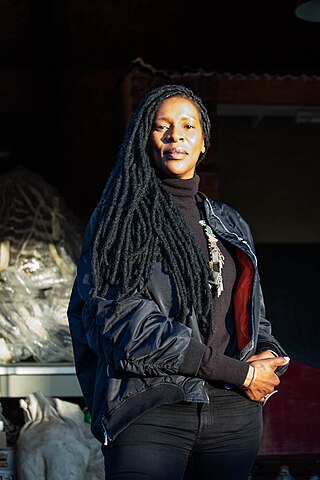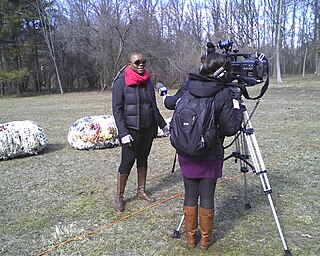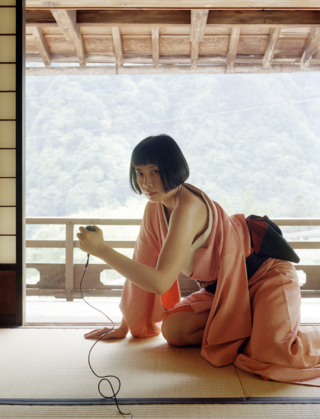
Renee Cox is a Jamaican-American artist, photographer, lecturer, political activist and curator. Her work is considered part of the feminist art movement in the United States. Among the best known of her provocative works are Queen Nanny of the Maroons, Raje and Yo Mama's Last Supper, which exemplify her Black Feminist politics. In addition, her work has provoked conversations at the intersections of cultural work, activism, gender, and African Studies. As a specialist in film and digital portraiture, Cox uses light, form, digital technology, and her own signature style to capture the identities and beauty within her subjects and herself.
Janine Gordon, better known by her professional name Jah Jah or MC Jah Jah, is an American rapper, photographer, and multimedia artist.
Bruce Silverstein Gallery is an art gallery in the Chelsea section of Manhattan, New York City. Founded in 2001 by Bruce Silverstein, the gallery represents contemporary and historically significant artists, emphasizing the exploration of both renowned and lesser-known works. The gallery is a member of the Association of International Photography Art Dealers.

Penelope Umbrico is an American artist best known for her work that appropriates images found using search engines and picture sharing websites.

Nandipha Mntambo is a South African artist who has become famous for her sculptures, videos and photographs that focus on human female body and identity by using natural, organic materials. Her art style has been self described as eclectic and androgynous. She is best known for her cowhide sculptures that connects the human form to nature.

Ariane Lopez-Huici is a photographer living between New York and Paris. Her work has been successfully presented internationally in institutions – Instituto Valenciano de Arte Moderno, Spain, Musee de Grenoble, France, PS1-Moma, US, French Institute New York, USA, among many others – as well as galleries – AC Project room, NY, Galerie Franck, Paris -. She has received a strong critical interest from prominent art historians and writers, such as Arthur Danto, Edmund White, Yannick Haenel, Julia Kristeva and Carter Ratcliff.

Dianne Smith is an abstract painter, sculptor, and installation artist. Her work has been exhibited in solo and group exhibitions in New York City's Soho and Chelsea art districts as well as, numerous galleries and institutions throughout the United States, and abroad. She is an arts educator in the field of Aesthetic Education at Lincoln Center Education, which is part of New York City's Lincoln Center For the Performing Arts. Since the invitation to join the Institute almost a decade ago she has taught pre k-12 in public schools throughout the Tri-State area. Her work as an arts educator also extends to undergraduate and graduate courses in various colleges and universities in the New York City area. She has taught at Lehman College, Brooklyn College, Columbia University Teachers College, City College, and St. John's University.
Kathy Grove is an American conceptual feminist photographer. As a professional photo retoucher for fashion magazines, Grove became familiar with airbrushing and photo manipulation techniques in that industry. Her work uses those skills to remove subjects from iconic works, or to alter their appearance. Grove wrote that this practice is intended to "portray women as they have been regarded throughout history, invisible and inaudible."[2] Her photo series, The Other Series, includes reproductions of canonical paintings in Western art with the feminine subjects removed.

The Quin is a luxury hotel in New York City. It is located on 57th Street and Sixth Avenue in Midtown Manhattan, two blocks south of Central Park.

Michèle Magema is a Congolese-French video, performance, and photography artist. She currently resides in Nevers.

Yijun Liao, also known as Pixy Liao, is a Chinese-American artist, living in New York City.
Roshini Kempadoo is a British photographer, media artist, and academic. For more than 20 years she has been a lecturer and researcher in photography, digital media production, and cultural studies in a variety of educational institutions, and is currently a professor in Photography and Visual Culture at the University of Westminster.

Zak Ové is a British-Trinidad visual artist who works between sculpture, film and photography, living in London and Trinidad. His themes reflect "his documentation of and anthropological interest in diasporic and African history, specifically that which is explored through Trinidadian carnival." In work that is "filtered through his own personal and cultural upbringing, with a black Trinidadian father and white Irish mother", he has exhibited widely in Europe, the United States and Africa, participating in international museum shows in London, Dakar, Paris, Dubai, Prague, Berlin, Johannesburg, Bamako and New York City. His father is the filmmaker Horace Ové and his sister is the actress Indra Ové.

Ming Smith is an American photographer. She was the first African-American female photographer whose work was acquired by the Museum of Modern Art (MOMA) in New York City.
Liz Johnson Artur is a Ghanaian-Russian photographer based in London, England. Her work documents the lives of black people from across the African Diaspora. Her work strives to display and celebrate the normal, the vibrant and the subtle nuances of each of these people lives that she encounters. Johnson Artur works as a photojournalist and editorial photographer for various fashion magazines and record labels all over the world, as well as her independent artistic practice. Her monograph with Bierke Verlag was included in the "Best Photo Books 2016" list of The New York Times.
Layla Love is an American photographer based in New York. Her works generally focus on disadvantaged, exploited, and trafficked people.
Omar Victor Diop is a Senegalese photographer whose conceptually-rich work is exhibited around the world. He lives and works in Dakar and Paris, France.
Adama Delphine Fawundu Adama Delphine Fawundu is an artist born in Brooklyn, NY the ancestral space of the Lenni-Lanape. She is a descendant of the Mende, Krim, Bamileke, and Bubi peoples. Her multi-sensory artistic language centers around themes of indigenization and ancestral memory. Fawundu co-published the critically acclaimed book MFON: Women Photographers of the African Diaspora with photographer Laylah Amatullah Barrayn. – MFON is a book featuring the diverse works of women and non-binary photographers of African descent. Her works have been presented in numerous exhibitions worldwide. She is a Professor of Visual Arts at Columbia University.
The Kamoinge Workshop is a photography collective that was founded in 1963. In 2013, the group stood as “the longest continuously running non-profit group in the history of photography.” The collective was born when two groups of African-American photographers came together in collaboration. The first group, named Kamoinge was founded by Louis Draper, James "Jimmie" Mannas, Al Fennar, and Herbert Randall. The second group, named Group 35 consisted of photographers Ray Francis, Earl Jones, Louis Draper, Herman Howard, Calvin Mercer, and Mel Dixon. Louis Draper was especially crucial to its founding. The first director of the group was Roy DeCarava, who led the collective from 1963 to 1965.

N'Goné Fall is a Senegalese curator, editor, and cultural policies consultant.










